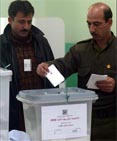Far right set to gain in Austria polls, but winner uncertain
Vienna -  While it was unclear whether the Social Democratic Party (SPOe) or the conservative People's Party (OeVP) would win Sunday's Austrian parliamentary elections, one thing seemed certain: Both were expected to suffer substantial losses to rightist parties.
While it was unclear whether the Social Democratic Party (SPOe) or the conservative People's Party (OeVP) would win Sunday's Austrian parliamentary elections, one thing seemed certain: Both were expected to suffer substantial losses to rightist parties.
Although the early elections could end the coalition between SPOe and its junior partner OeVP, which lasted 18 months, Austria's political future was unclear as both parties have ruled out joining forces with the far right.
According to the latest polls, the SPOe was set to win 28 or 29 per cent of the vote, up to 7 per cent less than in the 2006 elections.
Most forecasts showed the OeVP slightly behind at 26 to 28 per cent, up to 8 per cent less from 2006.
The conservatives, led by Vice Chancellor Wilhelm Molterer, ended the coalition and called for early elections in July over what they saw as a long-lasting political impasse in the government.
Even though this step promised a fresh political start and even though unpopular SPOe Chancellor Alfred Gusenbauer made Werner Faymann the new top candidate, many Austrians disappointed by the standstill were expected to pick far-right candidates.
Heinz-Christian Strache's right-wing Freedom Party was forecast to win 17 to 20 per cent of the vote while Joerg Haider's Alliance for the Future of Austria was expected to come in at 6 to 8 per cent.
The short election campaign season this summer was dominated by the issues of social welfare, tax cuts and worries about inflation, which stood at 3.7 per cent year-on-year in August, slightly lower than the 3.8-per-cent average among countries using the euro.
The OeVP and other parties came under pressure to prove their social credentials when the Social Democrats introduced a package of social spending and tax cuts weeks before the elections.
As the SPOe pushed most of the measures through parliament Thursday, election promises were delivered before voting had even started.
But it remained to be seen whether the move by Faymann could trump the right-wingers' campaigns, which have appealed to lower-income voters by claiming that immigrants are draining Austria's generous welfare system.
The OeVP sought right-wing voters by copying the Freedom Party's and Alliance for the Future of Austria's strategy of banking on public security and immigration.
Although only 15 per cent of Austrians favour continuing the "grand coalition" between the centre-left and centre-right, few viable alternatives might be available if the rightist parties are excluded from governing.
Both the main parties could form governments that could include the Greens or Liberals, but forecasts showed that such combinations would not yield majorities in parliament.
Austrians, who are used to stable governments, could be in store for more turbulent times.
The special session in parliament this week to pass social spending bills gave a glimpse of how a minority government with varying support from other parties could work: Without the support of the conservatives, the Social Democrats joined forces with the Freedom Party on some bills while insisting they would never form a government with the far right.
Of Austria's 8.3 million inhabitants, 6.3 million may cast ballots Sunday. For the first time, the voting age for parliamentary elections has been lowered from 18 to 16, adding around 3 per cent to the voting population. (dpa)